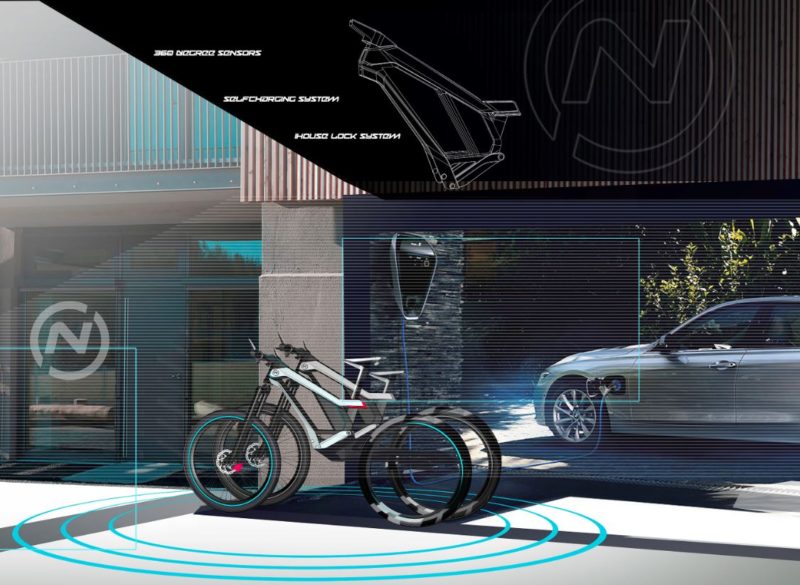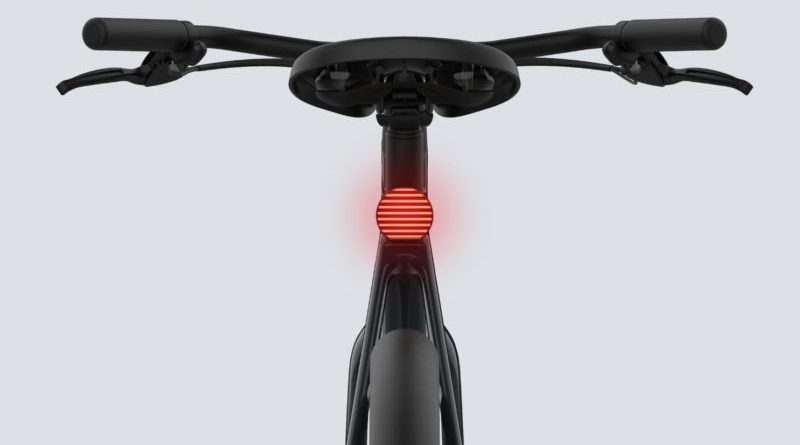Welcome to the age of the i-bike
We’ve gone out on a limb just ahead of Eurobike’s opening. Our prediction: you’ll be seeing a lot more never-before-seen tech integrated into bicycles and e-Bikes. So what does the future of bike design hold? We ask leading experts in tech…
What is the ‘next big thing’? That’s the billion dollar question on the minds of the bike industry’s designers, buyers and bosses. If you’re reading this at Eurobike, there’s a good chance you’re gauging the industry’s reaction to the innovations and marketing hype, perhaps trying to join the dots to form some basis of an emerging trend.
Well, we think we’ve spotted one that’s taken perhaps less time to develop than any prior; what’s more, if our crystal ball gazers are right, the bike industry runs a very real risk of letting the ‘next big thing’ escape its grasp. Why, you ask? Because the expertise to create the “i-Bike” largely doesn’t stem from within our industry.
That’s a notion shared by Randall Jacobs, the mind behind Thesis Bikes. In a former role Jacobs developed smart bike technology and was one of the pioneering minds behind a, for the time being, shelved smart bike infrastructure dubbed OpenBike. A former product developer for Specialized, Jacobs said, “Bike firms are good at mechanical, okay at integration, but not adept with technology like protocols and apps.”
That means outside experience, often expensive staff who are more akin to working in Silicon Valley, are required to take ideas to the next level. It’s perhaps for this reason, that the bike industry’s big disruptors in recent times have largely been outsiders.
“The electric bike share transition will come fast now. It’s burning through the kinds of VC cash the bike industry has never seen in a bid to gain market share and bankrupt the competition, that’s not behaviour we’re used to, but then again neither is the kind of tech explosion we’ve seen from dockless operators.”
The point that this is a different kind of business entirely is a valid one. Where the bike business has tried and often failed to get the attention of politicians and city planners, bike share’s explosion has forced cycling onto the urban mobility agenda. Whether it’s the financial clout of these companies, perceived dumping of bikes on pavements, or a growing feeling that electrified transport is the future, dockless has put cycling on the map as a transport form like no other marketing drive.
With car makers acknowledging that we’ve hit “peak car” in urban areas, the battleground for personal mobility is undoubtedly taking on a new shape and with new money. Just one automotive firm with eyes for cycling, BMW (whose e-Bikes are found with BH Bikes at Eurobike), let us in on its take of what the future has in store.
“It begins with a more specialist approach to the basic components; tougher chains and sprockets, for example, but the tech side is very much open to what the environment and paired tech permits,” explains Bjoern Koop, Product and Licence Manager, Mobility at BMW Lifestyle.
“On street infrastructure will be important in the grander scheme of how quickly things can develop. For example, our electric car chargers have functionality to charge an electric bike alongside. The two working in tandem could – depending on your situation – be the perfect match. Certainly we are thinking about the multi-modal journey. A folding bike tucks nicely into our Mini cars, the next step is to electrify this process and think about how we can support the bike journey from the car.”
The notion that your electric car could charge your electric bike as you drive is an easily envisaged near term reality, “it’s already possible,” says Koop. But what about if charging became less of a burden entirely.
 “We anticipate that, in time, you’ll not need to charge your bike, or at least the cyclist’s own effort will become most of the charge. There exists systems like Zehus that are dynamo generators for the battery. This kind of system might reduce the need for a bulky battery which naturally is an interesting thought for designers as it will enable new form factors and a more sculptural approach to the e-Bike,” says Eugene Maslow of Designworks. “In the future, batteries will be smaller, more effective and will be recharged on the flats, thus only put into use when they are needed,” he adds.
“We anticipate that, in time, you’ll not need to charge your bike, or at least the cyclist’s own effort will become most of the charge. There exists systems like Zehus that are dynamo generators for the battery. This kind of system might reduce the need for a bulky battery which naturally is an interesting thought for designers as it will enable new form factors and a more sculptural approach to the e-Bike,” says Eugene Maslow of Designworks. “In the future, batteries will be smaller, more effective and will be recharged on the flats, thus only put into use when they are needed,” he adds.
A pioneer in integrating tech into bikes, Vanmoof has long been admired in the bike world as ahead of its time in terms of urban transportation design. It’s little surprise then to hear the latest generation of bikes are cooking up some futuristic ideas.
Vanmoof’s Tessa Koesveld says: “To create the best city bike that beats any other means of transport, bikes kitted with integrated smart tech are appealing. The basics designed to lower the most common barriers to adoption are efficient pedal assist to take on distances, or hills of any kind and rider-recognition, which means they automatically lock or unlock. This makes chunky locks with keys you can lose a thing of the past. Our signature theft defence programmes enable bikes to defend themselves against thieves, automatically letting you know when they’re in danger.”
Thanks to embedded GPS technology in one of Vanmoof’s bikes and the overly generous pledge by the brand to recover customer’s stolen bikes, the famed Bike Hunters team was able to inadvertedly break up an international bike smuggling ring. How about that for customer service?
However, GPS is, in this day and age, on the more primitive side of what’s coming to market in terms of embedded tech. So what should we really be focusing on?
“The bike should become smart enough to eventually understand the rider,” says BMW’s Koop. “Innovations that tech-savvy consumers find in our cars today – like electric seat adjustment with memory, individual suspension set up or sensors to support tyre pressure recognition already hint at the user expectations the bike industry will have to meet soon.” That’s echoed and expanded upon by Jacobs who suspects the real value lies in what bike tech can learn about its users.
“There’s no shortage of demand for data and that applies to rider data too; that applies to the purchasing data right through to usage data. The knowledge of how to leverage such things ‘I think’ is in its infancy. Sell through data is now key, but tomorrow it could go a lot deeper than that,” says Jacobs. “If you sell through the IBD then the brand loses an element of data and you’re seeing brands try to recapture that info for whatever reason. Let’s say we own Strava, we could look at riders who have completed 500 miles in a set period of time and issue service prompts. That’s just one example of what could come to fruition.”
In his work with OpenBike, Jacobs sought to build a standard “operating system” for bicycles. This, it was theorised, would have operated off a single battery, but powered every single device, each of which would have been integrated by bike designers.
“Imagine if electric cars had several components with different chargers and the platform wasn’t communicating,” says Jacobs. “I think it’s nuts that integrated lights aren’t necessarily a standard thing on commuter bikes. When we were developing OpenBike, for example, we had a brake lever that, when pulled, would talk to the rest of the bike, turning on brake lights and shifting gears downwards in anticipation of needing to accelerate again.”
Communication between components does seem to be very much on the bike industry’s radar. As spotted by CI.N in February, Shimano appear to have filed a patent that softens or hardens suspension and alters e-Bike motor output, simply based on the position of the rider’s dropper post. Things like this are to be considered as safety features, believe those exploring the potential of i-Bikes, and not as some sort of soul-stripping of the cycling experience.
So should the bike shop fear a new tech-wave? 
We took to our trade-locked Facebook page – Cycling Industry Chat – to pitch that question to bike shops and the results are interesting. 57% of respondents suggested that more technology quite simply means more specialist knowledge. No different to the e-Bike’s arrival, specialist training means the ability to charge for a specialist service. What’s not to like? The remainder, however, ticked the box that said, “oh please, no more tech, leave it alone.” Like most natural change, ignore it at your peril, suggested the comments.
In Vanmoof’s case we’re told bike shops needn’t worry on the technical side.
“We sell our bikes worldwide which means our Bike Doctor partners are highly trained and able to service our bikes from a distance. The tech in our new range of ‘Electrifieds’ comes in compact smart cartridges. That means the ‘brains’ of the bike are tucked into a removable and replaceable cylinder, making it possible to repair the bike from a distance. Instead of a rider having to send the whole bike back, we simply ship the necessary replacement module,” explains Koesveld.
Proprietary tech may not be the long-term winner, though, believes Jacobs.
“This is a serious tech challenge that requires serious tech knowledge and investment if it is to become commonplace. With OpenBike we shot for an industry standard of sorts built using Can Bus; this is what most e-Bikes use to communicate electrical signals.”
Such a system is unlikely to become a simple OEM addition in the near term, we’re told. Instead bike designers would have to factor in the additions to their base drawings. However, production techniques could eventually make such things more straightforward, claims BMW.
“Production techniques will change tremendously as we move from designing products to designing and delivering services. We will end up with automated processes for making things. Bikes will be produced for one specific body versus mass production. This will also mean that the job landscape in the bike industry will change in time,” we hear from Designworks. “Smart technology very much exists to improve safety features in bicycles and motorbikes and that is an interesting avenue to explore,” says Koop. “We have already investigated the gyrometer smart balancing system to prevent motorbike crashes. We are also using technology that foresees dangerous situations, worked on helmets with VR displays that use this technology, and are also working on ABS systems for e-Bikes.”
With a broader world view on mobility than many in the bike business will enjoy, BMW is one of the few well placed to think outside of what exists on the market at present and create an entirely new category. Notably, for the first time Eurobike has dedicated an entire hall to e-Mobility this year. This may be indicative of future competitors to the bicycle and motorbike, suggests Koop.
 The motorbike segment is fast becoming electrified too. If we can spot an early trend it is that motorbikes are becoming smaller, smarter and more agile thanks to tech advances. Bicycles are going in the other direction; perhaps there will be a sensible middle ground, or something entirely different.”
The motorbike segment is fast becoming electrified too. If we can spot an early trend it is that motorbikes are becoming smaller, smarter and more agile thanks to tech advances. Bicycles are going in the other direction; perhaps there will be a sensible middle ground, or something entirely different.”
“From an overarching mobility perspective, one of the main challenges in the future will be the fact that bikes no longer exist in their sometimes complicated but manageable bike ecosystem where rules and recipes exist to solve problems”, adds Maslow. “Instead, the bike will become part of the complex mobility ecosystem in which too many unknowns and interrelated factors are involved to reduce the rules and processes. This means that, in addition to structures and specialist knowledge, a holistic and collaborative approach to innovation will be needed. For any industry this requires a huge mind-set shift.”
However you feel about the advance of smart technology, be it in the bike, on the street or in your store, we’re reassured of one certainty from BMW’s thought leaders. “People will be pleased to hear that the physical connection to the human body will always remain; hands, feet and bum,” concludes Maslow with an astute smile.



